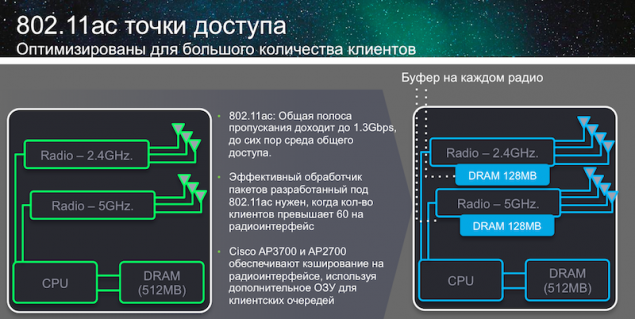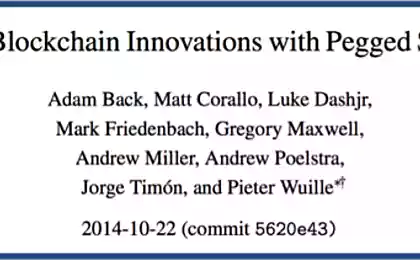1516
802.11ac access points Cisco: threshold Gigabit Wi-Fi passed
Once was ratified by the first wave Gigabit Wi-Fi - 802.11ac from Cisco, as one of the participants in the development of the standard, released the first AC-AP. They are the epitome of Cisco High Density Experience: an approach to the construction of high-speed Wi-Fi networks with a high density of connections.
To begin with a look at the major driving forces behind the development of Gigabit Wi-Fi. It is not always clear why transmit data at such speeds, when you use web surfing, watching videos on youtube or read posts in Facebook. Will it happen at a speed of 100 Mbit / s or 500 Mbit / s - connected user, by and large, do not care.
The advantages of the new standard are slightly different plane. The first of them - the density of connections to the access point. Nature wireless ester such that at one time can carry only one device. And if it is running at low speed, the other devices there is little time to transfer their pieces of information. As soon as we increase the speed of connections from clients that allows us a new standard 802.11ac, - airtime starting to be used more efficiently. Per unit time, more information can be transmitted, which means that more users can work on the same access point. Later in the article we give an example, when one such hotspot Cisco 2700 100 clients connect simultaneously.
The second important advantage - the battery life of mobile devices. It is logical to assume that if a smartphone or tablet spends less time on the unit of data transmission, its battery will last longer between charges. This video shows perfectly that when downloading a file to mobile smart phone over Wi-Fi 802.11ac battery for customers to save exactly 2 times!
In May, Cisco announced the 2700 series access points with full support for 802.11ac first wave. This means that the maximum transmission speed in the radio channel could reach 1.3 Gbit / s. The access point has three transmit and four receive radio-elements (MIMO 3x4) and a new architecture of distributed memory.

Cisco Access Point 2700 Series
Approach High Density Experience, involving a large number of customers to connect at high speeds, includes several mechanisms:
- The new architecture of the access points. Unlike competitive solutions on the market, Cisco 2700 and released before older sister Cisco 3700 have more memory on each radio interface. The traditional design with a single pool of memory came improved: new points each Cisco radio chip (2.4Ghz and 5Ghz) has its own buffer to 128MB. This allows to achieve higher efficiency in building sequence of packets from clients without overloading the CPU. The so-called architecture TurboBoost allows you to achieve better performance than the competition. This is confirmed by independent reports Miercom .

- Increase the speed of transmission of the client device using Client-Link 3.0
- Cisco Optimized Roaming - tripping mechanism "are stuck" customers. Customers located on the border of the access point, begin to transfer data at lower speeds, eating airtime. All this harm other customers and reduces their overall speed. It allows you to optimize roaming Cisco to override such "the stuck" mobile devices, causing them to look for a new access point or use the 3G-network.
New access points already tested in combat. Proof that they cope with a large number of customers and thus exhibit a high average speed is test conducted in conjunction with Cisco NSA Show. Without special engineering and specialized firmware settings, Cisco 2700 Access Point was able to demonstrate the simultaneous connection of 100 different types of customers.
Among them were both 802.11ac, 802.11n and mobile devices. The total aggregate data transfer rate was 316.9Mbit / s. It is an effective data rate at the level of TCP / UDP.

Source: NSA Show (http://nsashow.com/AP2700/)
Support for 802.11ac, a new hardware architecture and optimized roaming arrangements allow using the new Cisco AP 2700 and her older sister Cisco 3700 to implement the approach High Density Experience, in which significantly increases the number of connected clients, data rate, it is possible to transmit more capacious traffic and the use of mobile applications.
Useful materials about:
- AP 2700 series
- Access Point 3700 Series
- approach High Density Experience (HDX)
Yuri Dougan
Systems Engineer Cisco
Source: habrahabr.ru/company/cisco/blog/228587/
To begin with a look at the major driving forces behind the development of Gigabit Wi-Fi. It is not always clear why transmit data at such speeds, when you use web surfing, watching videos on youtube or read posts in Facebook. Will it happen at a speed of 100 Mbit / s or 500 Mbit / s - connected user, by and large, do not care.
The advantages of the new standard are slightly different plane. The first of them - the density of connections to the access point. Nature wireless ester such that at one time can carry only one device. And if it is running at low speed, the other devices there is little time to transfer their pieces of information. As soon as we increase the speed of connections from clients that allows us a new standard 802.11ac, - airtime starting to be used more efficiently. Per unit time, more information can be transmitted, which means that more users can work on the same access point. Later in the article we give an example, when one such hotspot Cisco 2700 100 clients connect simultaneously.
The second important advantage - the battery life of mobile devices. It is logical to assume that if a smartphone or tablet spends less time on the unit of data transmission, its battery will last longer between charges. This video shows perfectly that when downloading a file to mobile smart phone over Wi-Fi 802.11ac battery for customers to save exactly 2 times!
In May, Cisco announced the 2700 series access points with full support for 802.11ac first wave. This means that the maximum transmission speed in the radio channel could reach 1.3 Gbit / s. The access point has three transmit and four receive radio-elements (MIMO 3x4) and a new architecture of distributed memory.

Cisco Access Point 2700 Series
Approach High Density Experience, involving a large number of customers to connect at high speeds, includes several mechanisms:
- The new architecture of the access points. Unlike competitive solutions on the market, Cisco 2700 and released before older sister Cisco 3700 have more memory on each radio interface. The traditional design with a single pool of memory came improved: new points each Cisco radio chip (2.4Ghz and 5Ghz) has its own buffer to 128MB. This allows to achieve higher efficiency in building sequence of packets from clients without overloading the CPU. The so-called architecture TurboBoost allows you to achieve better performance than the competition. This is confirmed by independent reports Miercom .

- Increase the speed of transmission of the client device using Client-Link 3.0
- Cisco Optimized Roaming - tripping mechanism "are stuck" customers. Customers located on the border of the access point, begin to transfer data at lower speeds, eating airtime. All this harm other customers and reduces their overall speed. It allows you to optimize roaming Cisco to override such "the stuck" mobile devices, causing them to look for a new access point or use the 3G-network.
New access points already tested in combat. Proof that they cope with a large number of customers and thus exhibit a high average speed is test conducted in conjunction with Cisco NSA Show. Without special engineering and specialized firmware settings, Cisco 2700 Access Point was able to demonstrate the simultaneous connection of 100 different types of customers.
Among them were both 802.11ac, 802.11n and mobile devices. The total aggregate data transfer rate was 316.9Mbit / s. It is an effective data rate at the level of TCP / UDP.

Source: NSA Show (http://nsashow.com/AP2700/)
Support for 802.11ac, a new hardware architecture and optimized roaming arrangements allow using the new Cisco AP 2700 and her older sister Cisco 3700 to implement the approach High Density Experience, in which significantly increases the number of connected clients, data rate, it is possible to transmit more capacious traffic and the use of mobile applications.
Useful materials about:
- AP 2700 series
- Access Point 3700 Series
- approach High Density Experience (HDX)
Yuri Dougan
Systems Engineer Cisco
Source: habrahabr.ru/company/cisco/blog/228587/
Popularization of technical creativity in China
"Do No Harm", or How to avoid becoming a corporation























